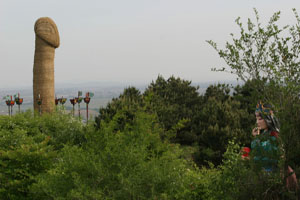| Tools: Save | Print | E-mail | Most Read |
| Debate Raised over Reproductive Organ Totem |
| Adjust font size: |
Longwan Shaman Amusement Park in northeast China's Changchun City has sparked a media frenzy by erecting the world's largest male reproductive organ totem to celebrate the First Shaman Culture Festival held on May 31. The totem is 9 meters high and has a diameter of 1.08 meters. Not content with its impressive girth, the builders also wrapped straw around the steel structure which towers atop a 300-meter high hill.
Due to the phallic totem, the Shamanist Amusement Park and Cheng Weiguang, president of the park, have understandably faced a barrage of questions from puzzled media. "I have heard a lot of criticism recently, but I can understand," said Cheng. "People do not understand the meaning of 'shamanism'. For many of them, it merely describes feudalistic superstition." To raise awareness of Shaman cultural protection, the Chinese Folk Literature and Art Society (CFLAC) shifted the Seventh Conference on Shamanism Research from Beijing to Changchun in 2004. In 2005, the park became officially known as the Study and Research Center for Shamanistic Culture by the CFLAC with Cheng one of the researchers on staff. Asked whether he would consider applying for the Guinness Record vis-à-vis the large reproductive organ, Cheng did not comment but he did say that Shamanistic culture should be included on the world cultural heritage list. According to Fu Yuguang, a Shamanism researcher, practices and beliefs that fall under the aegis of Shamanism have been recorded in around 40 countries. Furthermore, the Shaman folk epic confirms that the set of beliefs forms part of China's immaterial culture heritage. The reproductive organ totem is only one of eight distinctive landmarks in the park and as such should only be viewed as part of the whole, said Zhang Shouzhi, vice chairman of the Jilin Folk Art Association, adding that the others should not be neglected as they form an integral part of Shamanistic culture. (China.org.cn by Wu Nanlan, June 21, 2007) |
| Tools: Save | Print | E-mail | Most Read |
 |
| Related Stories |
|
